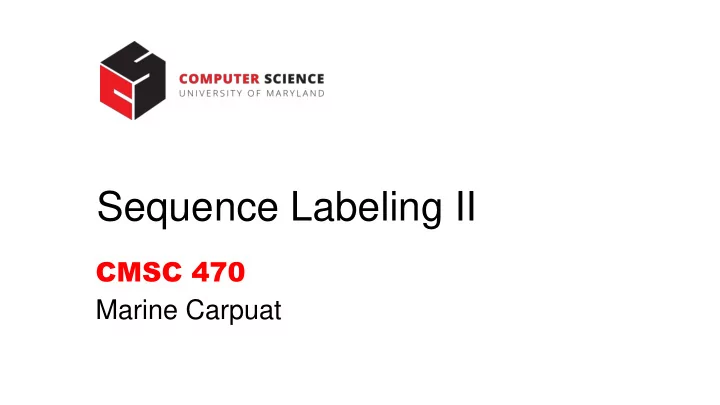

Sequence Labeling II CMSC 470 Marine Carpuat
Recap: We know how to perform POS tagging with structured perceptron • An example of sequence labeling tasks • Requires a predefined set of POS tags • Penn Treebank commonly used for English • Encodes some distinctions and not others • Given annotated examples, we can address sequence labeling with multiclass perceptron • but computing the argmax naively is expensive • constraints on the feature definition make efficient algorithms possible
We can view POS tagging as classification and use the perceptron again! = Algorithm from CIML chapter 17
Feature functions for sequence labeling • Standard features of POS tagging • Unary features: capture relationship between input x and a single label in the output sequence y • e.g., “# times word w has been labeled with tag l for all words w and all tags l” • Markov features: capture relationship between adjacent labels in the output sequence y • e.g., “# times tag l is adjacent to tag l’ in output for all tags l and l’” • Given these feature types, the size of the feature vector is constant with respect to input length Example from CIML chapter 17
Decomposability • If features decompose over the input sequence , then we can decompose the perceptron score as follows • This holds for unary and Markov features
Solving the argmax problem for sequences efficiently with dynamic programming • Possible when features decompose over input • We can represent the search space as a trellis/lattice • Any path represents a labeling of input sentence • Each edge receives a weight such that adding weights along the path corresponds to score for input/ouput configuration
Defining the Viterbi lattice for our POS tagger (assuming features from slide 4) • Each node corresponds to one time step (or position in the input sequence) and one POS tag • Each edge in the lattice connects from time l to l+1 , and from tag k’ to k
Defining the Viterbi lattice for our POS tagger (assuming features from slide 4) • When features decompose over input, we can • Define the score of the best path in lattice up to and including position l that labels the l-th word as k • And compute this score recursively Best prefix Score contribution of adding k to prefix up to l ending in k’
Deriving the recursion
Deriving the recursion
Deriving the recursion
Deriving the recursion
Deriving the recursion
Deriving the recursion
The Viterbi Algorithm Runtime 𝑃(𝑀𝐿 2 )
Key points in Viterbi algorithm Compute score of best possible prefix up to l+1 ending in k recursively Record backpointer to label k’ in position l that achieves the max At the end, take as the score of the best output sequence Follow backpointers to retrieve the argmax sequence
Recap: We know how to perform POS tagging with structured perceptron • An example of sequence labeling tasks • Requires a predefined set of POS tags • Penn Treebank commonly used for English • Encodes some distinctions and not others • Given annotated examples, we can address sequence labeling with multiclass perceptron • but computing the argmax naively is expensive • constraints on the feature definition make efficient algorithms possible • E.g, Viterbi algorithm
Note: one downside of the structured perceptron, we’ve just seen is that all bad output sequences are equally bad • With 0-1 loss 𝑚 0−1 (𝑧, ෞ 𝑧 1 ) = 𝑚 0−1 𝑧, ෞ 𝑧 2 = 1 • An alternative: minimize Hamming Los • gives a more nuanced evaluation of output than 0 – 1 loss Consider 𝑧 1 = 𝐵, 𝐵, 𝐵, 𝐵 ෞ Can be done with similar algorithms for 𝑧 2 = [𝑂, 𝑊, 𝑂, 𝑂] ෞ training and argmax
Sequence labeling tasks Beyond POS tagging
Many NLP tasks can be framed as sequence labeling • Information Extraction: detecting named entities • E.g., names of people, organizations, locations “ Brendan Iribe, a co-founder of Oculus VR and a prominent University of Maryland donor, is leaving Facebook four years after it purchased his company .” http://www.dbknews.com/2018/10/24/brendan-iribe-facebook-leaves-oculus-vr-umd-computer- science/
Many NLP tasks can be framed as sequence labeling x = [Brendan, Iribe , “,”, a, co -founder, of, Oculus, VR, and, a, prominent, University, of, Maryland, donor, “,”, is, leaving, Facebook, four, years, after, it, purchased, his, company, “.”] y = [B-PER, I-PER, O, O, O, O, B-ORG, I-ORG, O, O, O,B-ORG, I-ORG, I- ORG, O, O, O,B-ORG, O, O, O, O, O, O, O, O] “BIO” labeling scheme for named entity recognition
Many NLP tasks can be framed as sequence labeling • The same kind of BIO scheme can be used to tag other spans of text • Syntactic analysis: detecting noun phrase and verb phrases • Semantic roles: detecting semantic roles (who did what to whom)
Recommend
More recommend